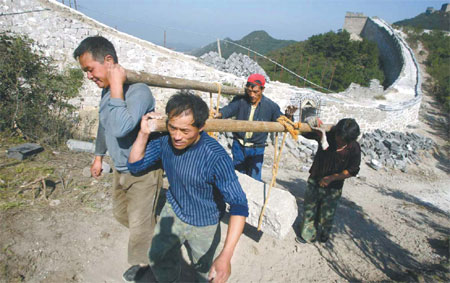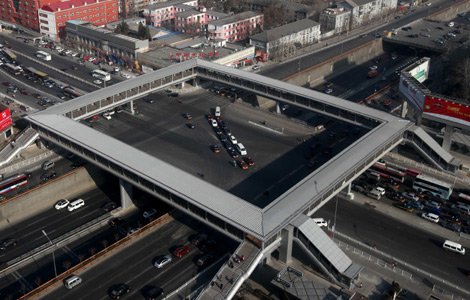Keeping the wall standing
Updated: 2012-01-08 08:01
By Xu Wei (China Daily)
|
|||||||||||
|
Workers manually carry huge stone slabs up the hill during the renovation of the Badaling section of the Great Wall. Provided to China Daily |
Making sure the Great Wall will still be here for posterity means building and re-building the old-fashioned way. Xu Wei reports.
When the workers in the Ming Dynasty (1368-1644) first built the Great Wall in Huairou district with animal power and human labor, they probably did not expect that it would be restored the same way hundreds of years later.
Wu Yunping, a 50-year-old migrant worker, hustles three mules, each carrying at least 20 bricks, across ravines and hills as steep as 60 degrees. A restored section of wall has already taken shape up those hills and there, his co-workers are busy putting the last binders in place and laying stones onto the top of towers.
Occasionally, they would have to chisel a stone to fit in the wall. At times they would carefully fill in with binders to keep loose bricks in place.
Wu yells at the animals time and again to maintain their momentum. Yet the animals would still pause each time they struggle up a slope to take a gasp of air. Some mules would even run away, totally oblivious to Wu's threat to give them heavier loads next time.
"In some areas even mules cannot get to, workers have to carry the stones to the construction area," says Cheng Yongmao, deputy chief engineer of the renovation project.
"It would physically exhaust a normal person to climb the hills with bare hands," says Cheng. "We've got all the machines, but there is no way we can get them up there."
The project, launched by the Beijing Municipal Authority of Cultural Heritage, will restore 3,553 meters of Great Wall near the Hefangkou village in Huairou district. The steep terrain on which this section sits has been the biggest obstacle posed to the renovation project here.
Trucks and tractors can only bring construction materials halfway up the mountain. From there, workers must rely on as many as 50 mules and a conveyer belt system to get it to the top of the hills.
More than 300 hundred workers, most from Hebei province, have been employed to work at the construction site.
Some, like Wu Yunping, are responsible for the delivery of construction material to the site and some are responsible for laying the stones and mixing the binders.
"We do exactly what the engineers tell us to do," says Zhang Shucai. "If they tell us it wasn't done properly and has to be torn down again, we simply follow the orders."
Although it is a renovation project, authorities say they are trying to replicate the Wall from the ancient period.
"The guiding principle is to maintain the authenticity of the walls and restore them according to the original," says Cheng.
According to him, experts and institutes have conducted a detailed study of the wall and the blueprint for each tower and wall section had been approved by the national cultural heritage authorities.
As part of their efforts to preserve the original construction style, Cheng says all the bricks were made to the original sizes. All the binders contain lime, which will give the renovated walls the antiquated look.
The project in the Hefangkou village has been the largest Great Wall renovation project so far in Beijing and it has a budget of 41.8 million yuan ($6.58 million). Despite the large investment, authorities say there are no plans to exploit it commercially.
"To develop it into a scenic spot takes a much more complicated process, inclusive of the facilities and regulation," says Cui Dapeng, an official from the Huairou cultural heritage authority. Instead, Cui describes it is as more of a landscaping project.
"It is part of the district's effort to build an international conference center besides Yanqi Lake. And the Hefangkou Great Wall project will be one of the spectacles displayed at a distance viewed from the conference center," Cui says.
Yet for local villagers who once carted off parts of the Great Wall to build their own houses before the 1980s, there is practical value in the renovation.
"More people will come, and the fruits we grow in the village will sell much better," says Wei Shuxian, a 75-year-old villager. And for posterity, there will be glimpses of glory in the past, and not so distant past.
You may contact the writer at xuwei@chinadaily.com.cn.
Hot Topics
Kim Jong-il, Mengniu, train crash probe, Vaclav Havel, New Year, coast guard death, Internet security, Mekong River, Strait of Hormuz, economic work conference
Editor's Picks

|

|

|

|

|

|








